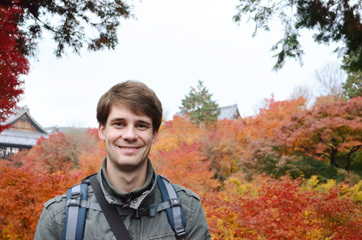Clinical Exchange in Japan
Welcome to Japan and Nagoya University school of Medicine!
Clinical Clerkship Report
Mr. Oliver Koenigsbruegge from Austria
Departments: Neurology, Pediatrics, Ophthalmology, Othrhinolaryngology
Period: October – December, 2012

A clinical clerkship in a foreign country, in my opinion is of immeasurable value for a medical student such as me. My opinion was confirmed during the stay at Nagoya University School of Medicine and I would like to explain why.
Historically, an exchange between Vienna University and Nagoya University in the field of medicine can be dated back as far as 1876, when a young doctor by the name of Albrecht von Roretz came to practice medicine in Nagoya and spread the knowledge obtained in his Austrian home. Frequently during my stay, I was made aware by Nagoya doctors that the international medical community is strongly connected and they recounted numerous occasions when they professionally and personally met doctors from Vienna. Especially the departments of pediatric hematology and neurology share connections with their Austrian counterparts.
To give a brief summary of the time I spent at the Medical School of Nagoya University, I would like to review the four departments I visited.
For the first four weeks of the clinical clerkship, I spent my time in the department of Neurology with Professor Sobue. As it was the first station of the rotation, I was first made familiar with the organization of the hospital, the patient rounds and the outpatient clinic. Several of the doctors in this department took the time to teach important clinical knowledge or the results of current research or showed how to perform neurological examinations such as EEG, myography, nerve conduction studies or how to take a neurological status.
The second department of my rotation was pediatrics of Professor Kojima. I spent time in the neonatal intensive care unit, the pediatric neurology team, the pediatric infectious disease team, pediatric cardiology and the pediatric hematology unit. It was possible to get an impression of the diverse clinical presentation of pediatric patients as well as to learn a lot about the research that is being done in pediatric cancer patients. As I also spent four weeks in this department, I was able to meet staff and patients on a personal level and learn about how to put this emotionally difficult field of medicine into perspective.
The department of ophthalmology of Professor Terasaki was next in my rotation. There I spent two weeks studying the process, the instruments and the techniques of diagnosing ophthalmologic patients. I was furthermore able to observe a number of operations with both the retina surgery group and the strabismus group. During my stay in this department the implications of preserving eyesight or reversing blindness became apparent to me while meeting patients with severe diseases of the eye.
Professor Nakashima’s department of otorhinolaryngology was last in my rotation. In both outpatient clinic and the operation room, I learned about common ENT diseases such as benign paroxysmal vertigo, otosclerosis, laryngitis and otitis media and their treatment. Further with the head-and-neck-surgery group I encountered patients with tumors of the upper airways and facial skeleton. This department also gave the possibility to practice some examinations and procedures such as laryngoskopy, otoscopy and audio-vestibular examinations.
Due to the size of the population in Aichi prefecture and the structure of the hospital system with Nagoya University as the most specialized institution in Aichi, I was able to see some very rare and academically interesting diseases or case presentations. In neurology I was able to learn a lot about the rare disease of amyotrophic lateral sclerosis because great emphasis is placed in the research of this otherwise rare disease. Some great scientific discoveries in this field were presented by top researchers who could explain their results and answer all my questions with pleasure.
The pediatric department was able to present rather clinical research data of patients with either rare diseases or rare combinations of complications in the course of treatment with bone marrow transplantations. Some of the results obtained in Professor Kojima’s research were recently presented at the annual meeting of the American Society of Hematologists in December, the most important hematological conference in the world.
On my personal request, the staff at the different departments allowed me to take some time off my daily schedule to work on independent research topics. With the study group at Vienna University, I have been working on finding risk factors for cancer-associated thrombosis. Because some of the fields I covered at Nagoya overlap this area, I was able to discuss my research with some of the hematologists and oncologists in Nagoya, who offered some advice on publication and presentation of results, which I found very valuable.
In this short time in Nagoya I could also see some of the staff on a more personal level and was surprised to see the happiness and positive attitude with which they approach their work every day. It was an inspiration to me to take pride in what I will do in the future and give my workplace a positive atmosphere. I will dearly treasure my memories of the time spent in Nagoya and hope to be able to continue some of the acquaintances I made as friendships in the future.
Click here to read other stories
Nagoya University Graduate School of Medicine